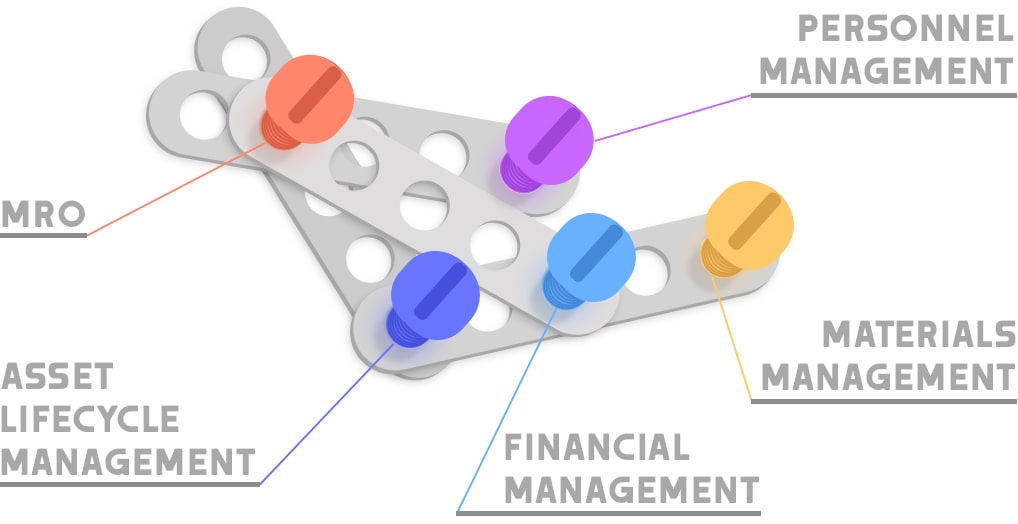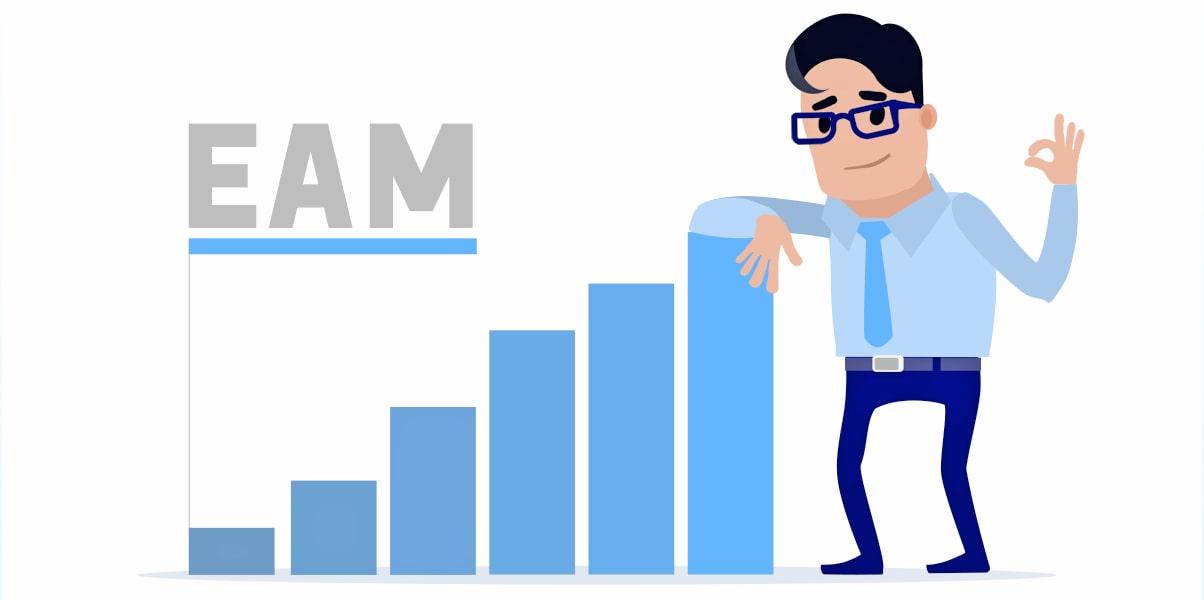- To the very beginning: what is EAM?
- Why do I need EAM?
- What are EAM implementation steps?
- What implementation tips can you give?
- Do you have EAM implementation example?
- Drawing the line
The purpose of many BI systems is to make organizations’ life easier, profit bigger and working conditions better. But no matter how appealing such systems can be, to get all their benefits you have to face the challenge – implementation process. However, today we want to prove all these challenges are surmountable on the example of one system implementation.
We will not torment you for long: we are talking about EAM implementation.
Definition and history
EAM is a system that was designed for making physical assets management and support. Enterprise asset management helps to improve assets’ quality, increase profit and maximize use. EAM systems were created for the needs of the companies with complex and expensive equipment and vehicles.
Functions
As you can see from the definition, EAM system is all about physical assets’ work improvement. Which functions does it include? There following must have EAM functions:
- Reducing unscheduled repairs and lower costs;
- Minimizing the risk of accidents;
- Real increase in the efficiency of maintenance and repair processes;
- Ensuring compliance and continuous monitoring of defects;
- Budget, work plan, purchases planning and monitoring.
Structure
The same as many maintenance systems, EAM has a modular structure. And that is logical and convenient as the modules’ content and number can vary regarding your needs. The basic modular structure includes:
- Asset lifecycle management
Helps to always keep companies equipment in a good working condition. It includes:
- Safe condition rendering
- Present condition monitoring;
- Repair and damage prevention.
- Financial management
Covers everything connected with budget planning, payments, equipment cost, profit and possible loss calculation.
- Materials management
One more important module, which helps to manage processes connected with material purchase and demand on it. Material management allows to have a full overview of inventory process and be aware of necessity to buy required material.
- Works and repairs planning and execution
Assist in planning repairs and works connected with equipment as well as control their execution in time.
- Personnel management
Helps to take care of efficient staff support. Includes:
- Training;
- Certification;
- Employee data;
- Motivation programs, etc
Why do I need EAM?
You still have doubts whether you need to start EAM implementation process? Of course, it is challenging, but here are some more proofs those implementation issues will pay off. Implementing EAM you’ll get:
- Reduced equipment maintenance cost
Reduction of materials stocks and spare parts in warehouses, maintenance and repair performing time, cost control and analysis help to reduce equipment maintenance cost as well.
- Unscheduled repairs number and their cost reduction
Critical works are performed primarily as the system always control their need and analyze possible outcomes. Statistics analysis together with reminder system assist in timely repairs preventing the future losses.
- Minimizing the risk of accidents
Workers security and stable enterprise operation are the highest priorities. That is why timely adoption of necessary technical solutions the causes of defects, failures, malfunctions and downtime analysis helps to lead the risk to minimum.
- Single database
Demand for multiple spreadsheets on multiple tools passed by. It is much more conveniently to use a single tool for all the processes. EAM allows managing all data and operations in one database.
- Budget understanding
When your budget is reduced, it is rather important to be aware of every single money spending. EAM software helps you keep tracking all expenses related to asset management. This valuable data can be used for budget planning.
What are EAM implementation steps?
And now, when you finally realized the value and importance of EAM for your company we are moving to the first stage of your organization’s life changing – implementation process.
To make this process easier it is better to follow the particular steps. And, of course, we are ready to share those steps with you:
Step one: preparation
What is the key to success of every great project? An appropriate preparation. After making the decision of EAM implementation you already have the clear idea: you need EAM and you know why. However, it is better to discuss with your team once again what exactly you expect to get. Make a list of clear expectations and must have the future system should include. This step also involves the choose of the right vendor. By the way, the list of top EAM vendors you can find in our article EAM.
Step two: analysis
In the course of the analysis, the main efforts are focused on the study and accurate formalization of those business processes that are supposed to be implemented in the system during the upcoming implementation phase. At this stage classifiers and equipment structure development is underway. This is one of the main tasks, since the structure of the equipment influences its search in the system, the planning of repairs, the preparation of analytical reports, etc. First of all, you need to understand that there are no ready-made and convenient classifiers. The most convenient is the one that will be developed for the particular customer.
Step three: system’s design
The project phase begins with more detailed training for key users on how to work with the EAM system. Vendors familiarize the customer with the system standards and demonstrate how certain business processes are implemented in it. Training is necessary for the approval of a conceptual model, an understanding of the need to change business processes “as is” in business processes “as will be”. If possible, they will change in the direction of maximum adaptation to standard EAM-system processes.
To solve the design problem on the customer's server, a prototype of the future system is deployed. Then, functional requirements for the system are developed, in which all the terminology used is fixed, business processes are described “as will be”, rights and roles of users are defined, etc.
Step four: development stage
And here the creation begins. Moving on to the most time-consuming project phase, the task of which is to create a fully configured, working system. Source data is loaded into the system from templates prepared at the design stage. The system is configured in accordance with the “how will” business processes agreed with the customer; solutions are created for integration with external programs, reporting forms, etc. Much attention is paid to project management - setting priorities and allocating resources, as well as making changes: defects are identified and corrected, requests for changes are made and agreed with the customer.
The result - a comprehensive testing system, the results of which are confirmed by the acts of work performed. After successful testing, it is necessary to develop, together with the customer’s employees, programs and schedules for end-user training, according to which the staff will be fully trained in working with the system.
Step five: implementation
Only after going through all the previous steps implementation itself finally starts. It specialists develop a plan for the transition of the system to commercial operation, produce a final load of initial data and other important info. In addition, the vendor provides end-user with training of relevant skills for working with the new system and develops user documentation.
After the training, before putting the system into operation, the control testing of key users is carried out to determine the possibility of admission to work or the need for additional training.
Step six: industrial exploitation
The bottom line of EAM – industrial exploration. The goal of the stage is to transfer the EAM system to exploration and subsequent implementation of technical support.
At the final stage:
- the initial data are checked, input of additional information directly by users of the system;
- practical operation of the system on real data, users getting used to work in the system;
- constant monitoring of user actions by specialists.
The result of this stage and the project as a whole is the successful operation of the system.
What implementation tips can you give?
So, now you have a whole EAM implementation guide following which accurately you will definitely come to success in your implementation. However, making this process even easier and result even better also possible. How? Here are some useful tips for you:
- At system designing stage make sure the future system corresponds the following criteria:
- Has an acceptable price;
- Covers current tasks in the field of maintenance and repair, including industry-specific ones;
- Has the prospect of development;
- Has a positive retrospective in the form of implemented projects.
Exactly those characteristic present in a successful EAM system.
- Estimate the real and fare enterprise readiness for implementation. Give the current state of fixed assets an estimation, analyze their management activities and identification of weak points. You can’t deny, it will be a shame to fail implementation due to the initial unavailability.
- Choose EAM implementation leader. Without any doubts, implementation should involve all employees participation. That is why you should choose a person or organize responsible team to control this complex process.
- Training, training and training. Educating users to effectively use the EAM system is essential to the overall success of the implementation. However, this is the only first part, you should also include general training in the principles of asset management business processes used in the system. It should also highlight the benefits for individual working roles using the system.
Do you have EAM implementation example?
The last question is left. The last but not the least, however, because what are the words without a particular example? And who would we be handing out tips without going through all the steps ourselves? Exactly, we have an implementation example based on our experience.
GalaktikaSoft designed and implemented an EAM solution for big European enterprise software development company with 1,200 long-standing clients. The challenge was to create EAM system, which will efficiently monitor maintenance processes, evaluate risks of equipment failure and manage clients’ assets.
The system had to have the following functions:
- Equipment technical state monitoring;
- Risks evaluation;
- KPI assessment;
- Scheduling maintenance.
All the modules were developed with a help of Xafari Framework. There were five
of them:
1. Asset management module;
2. Personnel management;
3. The maintenance and repair module;
4. The Docflow module;
5. Finance management module.
As a result, our EAM solution manages the entire life cycle of a company's assets, tracking their functional status, planning regular maintenance work and reducing maintenance and repair costs. This enterprise asset management software allows users to analyze which assets are most important for a business, and first of all spend money on their services.
The EAM system already has thousands of end users. For more information, follow our case study.
Drawing the line
Now you know: the challenges seem to be hard only if you don’t have a plan to overcome them. Be patient, follow the steps and tips, take care of details and success will find you. So decide on changes and have a great implementation!




